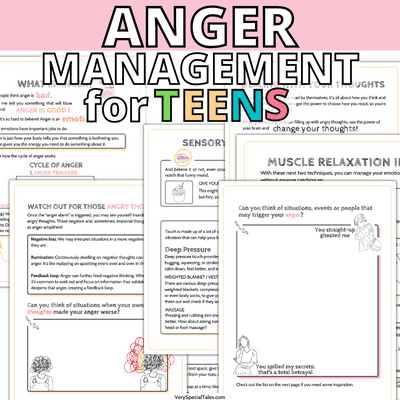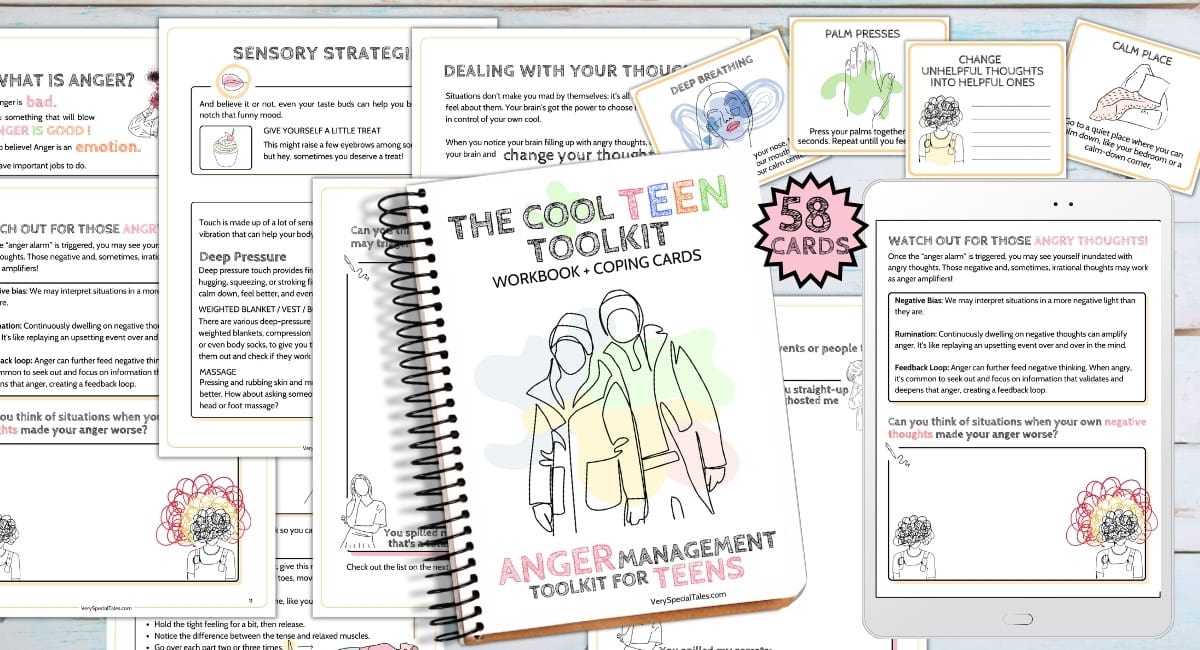
Most Effective Anger Management Activities for Teens
Anger management activities for teens: Explore anger signs and triggers in teens and learn effective anger management techniques to help your teenage kid or student address their frustrations in a positive way.
Navigating the teenage years can be a rollercoaster. Amid hormonal changes, mood swings, and the pressures of school and social life, young people often find themselves grappling with intense emotions, including anger. Understanding and managing this anger in healthy ways is crucial for their well-being and relationships.
Table of Contents
- What is Anger?
- Anger Issues in Teens
- Anger Triggers
- Recognizing Anger Signs
- Anger Management Activities for Teens
- Other Anger Management Activities and Resources
What is Anger?
Anger is a basic emotion we all experience.
Anger is a natural emotion, a response to a perceived threat, injustice, or frustration.
Anger is NOT bad. Although it is described as a negative emotion when considering its emotional value, it can also be a healthy emotion. When anger motivates positive change through problem-solving, addressing injustice, or dealing with perceived threats, it serves its ultimate purpose.
However, uncontrolled anger can have negative consequences.
Anger Issues in Teens
A survey of 6483 adolescents (aged 13-17 years old) carried out in the USA to produce data on mental disorders among youth identified that (63.3%) of adolescents reported at least one lifetime anger attack involving destroying property, threatening violence, or engaging in violence.
The teenage years are a period of profound physical and mental transformation.
Many changes in this life stage can contribute to teenage anger, such as:
- Hormonal changes.
The teenage years are synonymous with puberty, a time when the body undergoes significant hormonal changes that could lead to mood swings, anger or irritability. - Cognitive development.
During adolescence, the brain is still developing, especially the prefrontal cortex, which is responsible for decision-making, impulse control, and understanding consequences. This incomplete development can lead teens to make impulsive decisions, which, when combined with frustration, can result in angry outbursts. - Identity formation.
As teens try to find their own path and be themselves, they might bump heads with what their family or society expects of them. This can make them feel like no one gets them, leading to frustration and anger. - Peer pressure and social dynamics.
Peer influence peaks during the teenage years. Trying to fit in and dealing with bullies or feeling left out can really set off anger. Plus, when all you want is to be part of the group and feel accepted, any hint of rejection can make them upset or even lash out. - Seeking autonomy.
The teenage years also come with a natural desire for increased independence that can clash with parental controls and restrictions. - Struggling with mental health.
Many mental health issues, such as depression, anxiety, or substance abuse, can begin or intensify during the teenage years. Such disorders can heighten feelings of frustration, sadness, or isolation, sometimes leading to angry outbursts as a way of coping.
Anger management skills are essential for teens to navigate emotions and handle challenges and difficult situations effectively.
Anger Triggers in Teens
An anger trigger is anything that provokes an angry emotional response.
What sets your teen off may vary and is shaped by their life experiences, what they believe in, or how they’re feeling at the moment.
Recognizing their anger triggers will improve their emotional regulation, allowing them to anticipate and respond to anger-provoking situations.
Young adults and middle school students may encounter a myriad of triggering events.
Examples of potential anger triggers that young adults and middle school students may encounter include:
- Feeling left out or ignored.
- Feeling teachers or other adults treat them unjustly.
- Relationship breakups: Ending relationships or friendships.
- Seeing others succeed or get something they want / jealousy.
- Feeling like no one ‘gets’ them.
- Experiencing/witnessing bullying, discrimination or prejudice.
- Feeling confined or like strict curfews.
- Being teased.
- Feeling betrayed.
Each teen is unique, and different reasons may trigger their anger.
Related Reading: Anger Triggers in Kids
Recognizing Signs of Anger
Anger signs are indicators or symptoms that someone is experiencing anger.
For teens, recognizing these warning signs in themselves is crucial for understanding and effectively managing their emotions.
Anger signs can be:
- Physical symptoms like rapid heartbeat, shaking or clenching fists.
- Negative thoughts.
- Emotional signs like feelings of resentment, ruminating about the anger situation, feeling you are about to lose control.
- Behavioral signs like yelling, slamming doors, aggressive behavior, or isolating from others.
Related: Anger Signs in Kids
Anger Management Activities for Teens
An anger management activity is a structured exercise or technique aimed at helping people identify, address, and express their anger in positive ways, leading to fewer aggressive reactions and promoting better responses to challenging situations.
The following anger activities are powerful tools that might help teens navigate their emotions effectively:
Deep Breathing and Belly Breathing
Encouraging your teen to take deep breaths can help reduce their heart rate and calm intense emotions. Belly breathing, in particular, is a valuable tool.
Breathing exercises can be highly effective in managing anger for several reasons:
- Physiological regulation: Deep breathing helps neutralize our body’s ‘fight or flight’ response, which leads to increased heart rate, blood pressure, and fast breathing. Deep breathing helps counteract this response by activating the body’s “rest and digest” system, which calms the body down.
- Distraction: Focusing on breathing acts as a distraction, allowing a temporary break from the situation or thoughts that are causing anger.
- Oxygen supply: Deep breathing ensures more oxygen flows to the brain. A well-oxygenated brain functions better, promoting clearer thinking and better decision-making.
- Mindfulness and presence: Breathing exercises often have a grounding effect, helping us become more present in the moment. This can prevent dwelling on the cause of anger and can make it easier to approach situations rationally.
Related resource: 14 Fun Breathing Exercises that Kids Will Love.
Progressive Muscle Relaxation & Other Muscle Relaxation Activities
Progressive Muscle Relaxation (PMR) and other muscle relaxation techniques are excellent tools to combat anger.
Some of the reasons these muscle relaxation techniques work are:
- Physiological response: Anger often manifests physically, with our muscles tensing up. Muscle relaxation exercises target this tension. By consciously tensing and then relaxing different muscle groups, we can counteract this physical manifestation of anger.
- Focus and distraction: The process of moving through each muscle group requires concentration and focus. This diverts attention away from the anger-inducing situation.
- Activation of Relaxation Response: Just as deep breathing activates the body’s parasympathetic system (often called ‘rest and digest’), PMR also encourages this relaxation response. This helps to mitigate the heightened physiological state brought on by anger.
PMR involves tensing and then relaxing muscle groups, helping teens release physical tension related to their angry feelings. Starting from the toes and working up to the head, it helps release physical tension and promotes overall relaxation.
Teach Problem-Solving Skills
Sometimes, anger signals the need to fix something that is bothering or frustrating. Problem-solving skills provide teens with strategies to address anger effectively, transforming conflicts into life lessons.
The basic steps to problem-solving that your teen needs to apply are:
- Identifying a problem.
- Brainstorming potential solutions.
- Assessing positive and negative outcomes for those solutions.
- Choosing the best solution.
- Taking action!
Regular Exercise and Team Sports
Exercise releases endorphins, which are natural mood lifters, helping to alleviate anger and stress. Physical activity provides an outlet for pent-up emotions and redirects aggressive energy. Regular exercise promotes overall emotional well-being and aids in anger management.
Social Skills: Communication Skills Training
Improving communication skills can help teens articulate their feelings and needs clearly without resorting to aggression. By learning to speak openly and listen carefully, we can solve problems without arguing, cutting down on confusion and hurt feelings.
Effective communication equips teens with tools to assert themselves calmly, preventing bottled-up emotions that can intensify anger.
Anger Management Worksheets and Workbooks
An anger workbook is a practical tool that helps teens identify their anger triggers and devise healthy coping skills. The worksheets can be a great way for teens to reflect on specific situations and their reactions.
- Check out our very comprehensive anger toolkit for teens: Cool Teen Toolkit.
Anger Games for Kids & Teens
Anger management games are another fun and effective tool to learn healthy coping strategies. Learning while playing is an engaging experience that also promotes social interaction and allows teens to practice anger strategies in a safe environment.
Examples of anger games include Mad Dragon, Temper Tamers, or the Anger Management Thumball. For a detailed article on anger management games, check out:
- Anger Games: 14 super fun ways to learn anger management skills.
Journaling
Anger, while a normal emotion, can sometimes become overwhelming. Journaling can be an effective way to gain insights into our thoughts, triggers, and feelings and help identify effective strategies to manage and express anger constructively.
For more serious problems, like unmanaged anger leading to substance abuse or mental illness, seeking professional help is crucial. Cognitive Behavioral Therapy (CBT), often facilitated by mental health professionals or social workers, teaches young adults to address negative emotions and develop problem-solving skills.
Sometimes, the root cause of a child’s anger lies in family dynamics. Family therapy can be a valuable resource in such cases, helping the entire family develop better communication and problem-solving skills.
Recognizing the signs of an angry child and understanding one’s own reactions to their anger is pivotal. Parents can play a crucial role in their child’s anger management journey by fostering safe spaces for open conversations and ensuring the home environment feels like a safe place. Consistent support and the right tools can transform challenges into growth opportunities.
Other Anger Management Activities and Resources
Other kid and teen anger management valuable resources that you may consider exploring include:
Anger Iceberg for Kids
The anger iceberg metaphor represents there are many hidden layers of feelings camouflaged under the more explicit anger emotion.
Our Anger Iceberg for Kids article shares a step-by-step explanation of how to use this powerful anger management activity to help kids understand other feelings hidden behind anger. It also includes a printable PDF.
Anger Thermometers
An anger thermometer is a visual tool that assists kids, teens, and adults in communicating emotional states, labeling their angry feelings, expressing intensity or levels of anger, and understanding how their feelings of anger may escalate.
Our Anger Thermometers article shares ideas on using this anger management tool and includes 11 free downloadable thermometers.
Calming Boxes / Calm-Down Corners
When kids need to put their coping skills to good use, it can be impractical to start looking around the house for toys, books, or tools to help them calm down.
Having a calm-down toolbox allows you to easily access all the items that facilitate your kids’ calm-down strategies. This article explores different items you may consider adding to your toolkit:
This is a very helpful guide to help you implement this tool at home or school:
Calming Strategies for Anger
Calming strategies for kids are tactics, activities, worksheets, or exercises aimed to help reduce their anxiety, anger, overexcitement, or tension. Explore more than 100 ideas to include in your coping strategies repertoire. Examples of additional strategies to the ones we have already mentioned include:
- Distraction strategies (fun activities to redirect the focus of attention from anger).
- Mindfulness and meditation.
- Deep pressure and massage.
- Sensory Strategies.
Anger Management for Children
This is a great article if you are looking for ideas to help younger children with their anger. It shares anger management strategies for small children and some useful tools like an anger scale for kids or calm-down cards.
Check out our Anger Management Worksheets below!




